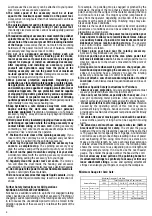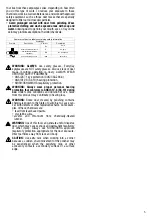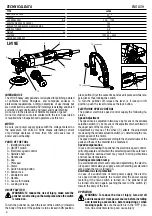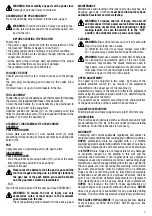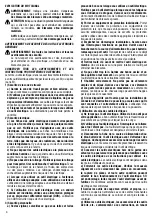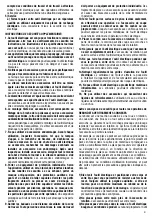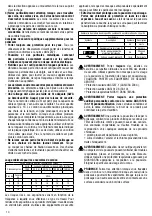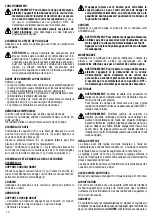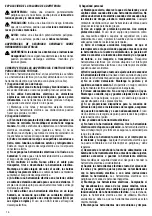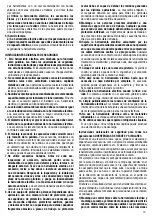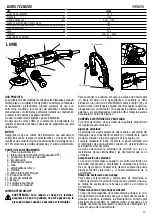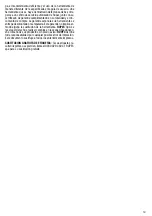
4
Further Safety Instructions for All Operations
KICKBACK AND RELATED WARNINGS
Kickback is a sudden reaction to a pinched or snagged rotating
wheel, backing pad, brush or anyother accessory. Pinching or
snagging causes rapid stalling of the rotating accessory which
in turn causes the uncontrolled power tool to be forced in the
direction opposite of the accessory’s rotation at the point of the
binding.
For example, if a polishing mop is snagged or pinched by the
workpiece, the edge of the mop that is entering into the pinch
point can dig into the surface of the material causing the mop
to climb out or kick out. The mop may either jump toward or
away from the operator, depending on direction of the mop’s
movement at the point of pinching. Polishing mops may also
break under these conditions.
Kickback is the result of tool misuse and/or incorrect operating
procedures or conditions and can be avoided by taking proper
precautions as given below:
1) Maintain a firm grip on the power tool and position your
body and arm to allow you to resist kickback forces. Always
use auxiliary handle, if provided, for maximum control over
kickback or torque reaction during start up. The operator
can control torque reaction or kickback forces, if proper
precautions are taken.
2) Never place your hand near the rotating accessory.
Accessory may kickback over your hand.
3) Do not position your body in the area where power tool
will move if kickback occurs. Kickback will propel the tool in
direction opposite to the wheel’s movement at the point of
snagging.
4) Use special care when working corners, sharp edges, etc.
Avoid bouncing and snagging the accessory. Corners, sharp
edges or bouncing have a tendency to snag the rotating
accessory and cause loss of control or kickback.
5) Do not attach a saw chain woodcarving blade or toothed
saw blade. Such blades create frequent kickback and loss of
control.
Additional Specific Safety Instructions for Polishers
• Always use eye protection. All users and bystanders must
wear eye protection that conforms to ANSI Z87.1.
• Clean out your tool often, especially after heavy use. Dust
and grit containing metal particles often accumulate on
interior surfaces and could create an electric shock hazard.
• Do not operate this tool for long periods of time. Vibration
caused by the operating action of this tool may cause
permanent injury to fingers, hands and arms. Use gloves to
provide extra cushion, take frequent rest periods and limit daily
time of use.
• Air vents often cover moving parts and should be avoided.
Loose clothes, jewelry or long hair can be caught in moving
parts.
• An extension cord must have adequate wire size (AWG or
American Wire Gauge) for safety. The smaller the gauge
number of the wire, the greater the capacity of the cable, that
is 16 gauge has more capacity than 18 gauge. An undersized
cord will cause a drop in line voltage resulting in loss of power
and overheating. When using more than one extension to
make up the total length, be sure each individual extension
contains at least the minimum wire size. The following table
shows the correct size to use depending on cord length and
nameplate ampere rating. If in doubt, use the next heavier
gauge. The smaller the gauge number, the heavier the cord.
Further Safety Instructions for All Operations
KICKBACK AND RELATED WARNINGS
Kickback is a sudden reaction to a pinched or snagged rotating
wheel, backing pad, brush or anyother accessory. Pinching or
snagging causes rapid stalling of the rotating accessory which
in turn causes the uncontrolled power tool to be forced in the
direction opposite of the accessory’s rotation at the point of the
binding.
For example, if a polishing mop is snagged or pinched by the
workpiece, the edge of the mop that is entering into the pinch
point can dig into the surface of the material causing the mop
to climb out or kick out. The mop may either jump toward or
away from the operator, depending on direction of the mop’s
movement at the point of pinching. Polishing mops may also
break under these conditions.
Kickback is the result of tool misuse and/or incorrect operating
procedures or conditions and can be avoided by taking proper
precautions as given below:
1) Maintain a firm grip on the power tool and position your
body and arm to allow you to resist kickback forces. Always
use auxiliary handle, if provided, for maximum control over
kickback or torque reaction during start up. The operator
can control torque reaction or kickback forces, if proper
precautions are taken.
2) Never place your hand near the rotating accessory.
Accessory may kickback over your hand.
3) Do not position your body in the area where power tool
will move if kickback occurs. Kickback will propel the tool in
direction opposite to the wheel’s movement at the point of
snagging.
4) Use special care when working corners, sharp edges, etc.
Avoid bouncing and snagging the accessory. Corners, sharp
edges or bouncing have a tendency to snag the rotating
accessory and cause loss of control or kickback.
5) Do not attach a saw chain woodcarving blade or toothed
saw blade. Such blades create frequent kickback and loss of
control.
Additional Specific Safety Instructions for Polishers
• Always use eye protection. All users and bystanders must
wear eye protection that conforms to ANSI Z87.1.
• Clean out your tool often, especially after heavy use. Dust
and grit containing metal particles often accumulate on
interior surfaces and could create an electric shock hazard.
• Do not operate this tool for long periods of time. Vibration
caused by the operating action of this tool may cause
permanent injury to fingers, hands and arms. Use gloves to
provide extra cushion, take frequent rest periods and limit daily
time of use.
• Air vents often cover moving parts and should be avoided.
Loose clothes, jewelry or long hair can be caught in moving
parts.
• An extension cord must have adequate wire size (AWG or
American Wire Gauge) for safety. The smaller the gauge
number of the wire, the greater the capacity of the cable, that
is 16 gauge has more capacity than 18 gauge. An undersized
cord will cause a drop in line voltage resulting in loss of power
and overheating. When using more than one extension to
make up the total length, be sure each individual extension
contains at least the minimum wire size. The following table
shows the correct size to use depending on cord length and
nameplate ampere rating. If in doubt, use the next heavier
gauge. The smaller the gauge number, the heavier the cord.
• Do not allow any loose portion of the polishing bonnet or
its attachment strings to spin freely. Tuck away or trim any
loose attachment strings. Loose and spinning attachment
strings can entangle your fingers or snag on the workpiece.
Just because the accessory can be attached to your power
tool, it does not assure safe operation.
4.The rated speed of the accessory must be at least
equal to the maximum speed marked on the power tool.
Accessories running faster than their rated speed can break
and fly apart.
5.The outside diameter and the thickness of your accessory
must be within the capacity rating of your power tool.
Incorrectly sized accessories cannot be adequately guarded
or controlled.
6.Threaded mounting of accessories must match the polisher
spindle thread. For accessories mounted by flanges, the
arbour hole of the accessory must fit the locating diameter
of the flange. Accessories that do not match the mounting
hardware of the power tool will run out of balance, vibrate
excessively and may cause loss of control.
7.Do not use a damaged accessory. Before each use
inspect the accessory such as backing pad for cracks,
tear or excess wear. If power tool or accessory is dropped,
inspect for damage or install an undamaged accessory.
After inspecting and installing an accessory, position
yourself and bystanders away from the plane of the
rotating accessory and run the power tool at maximum
no-load speed for one minute. Damaged accessories will
normally break apart during this test time.
8.Wear personal protective equipment. Depending on
application, use face shield,safety goggles or safety glasses.
As appropriate, wear dust mask, hearing protectors, gloves
and workshop apron capable of stopping small abrasive or
workpiece fragments. The eye protection must be capable
of stopping flying debris generated by various operations.
The dust mask or respirator must be capable of filtrating
particles generated by your operation. Prolonged exposure to
high intensity noise may cause hearing loss.
9.Keep bystanders a safe distance away from work area.
Anyone entering the work area must wear personal
protective equipment. Fragments of workpiece or of a broken
accessory may fly away and cause injury beyond immediate
area of operation.
10.Hold power tool by insulated gripping surfaces only, when
performing an operation where the cutting accessory may
contact hidden wiring or its own cord. Cutting accessory
contacting a “live” wire may make exposed metal parts of the
power tool “live” and shock the operator.
11.Position the cord clear of the spinning accessory. If you
lose control, the cord may be cut or snagged and your hand
or arm may be pulled into the spinning accessory.
12.Never lay the power tool down until the accessory has
come to a complete stop. The spinning accessory may
grab the surface and pull the power tool out of your control.
13.Do not run the power tool while carrying it at your side.
Accidental contact with the spinning accessory could snag
your clothing, pulling the accessory into your body.
14.Regularly clean the power tool’s air vents. The motor’s
fan will draw the dust inside the housing and excessive
accumulation of powdered metal may cause electrical hazards.
15.Do not operate the power tool near flammable materials.
Sparks could ignite these materials.
16.Do not use accessories that require liquid coolants. Using
water or other liquid coolants may result in electrocution or
shock.
Volts
120 V
25 (7,6)
50 (15,2) 100 (30,5) 150 (45,7)
More Than
No More Than
0
6
18
16
16
14
6
10
18
16
14
12
10
12
16
16
14
12
12
16
14
12
Not Recomended
Minimum Gauge for Cord Sets
Ampere Rationg
Total Lenght of Cord in Feet (meters)
AWG
Minimum Gauge for Cord Sets
Summary of Contents for LH19E
Page 2: ......




